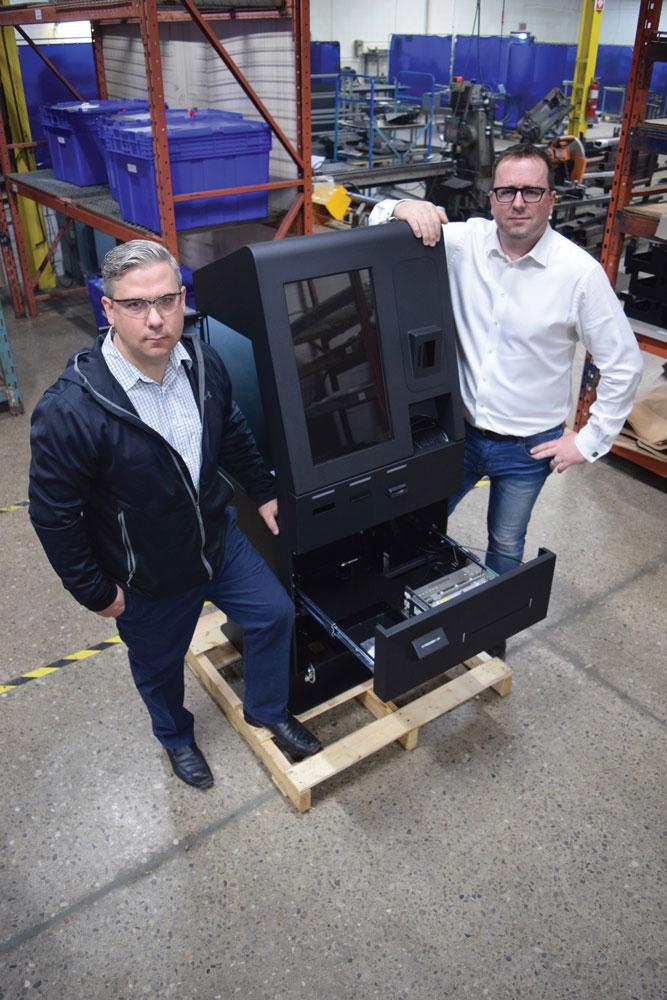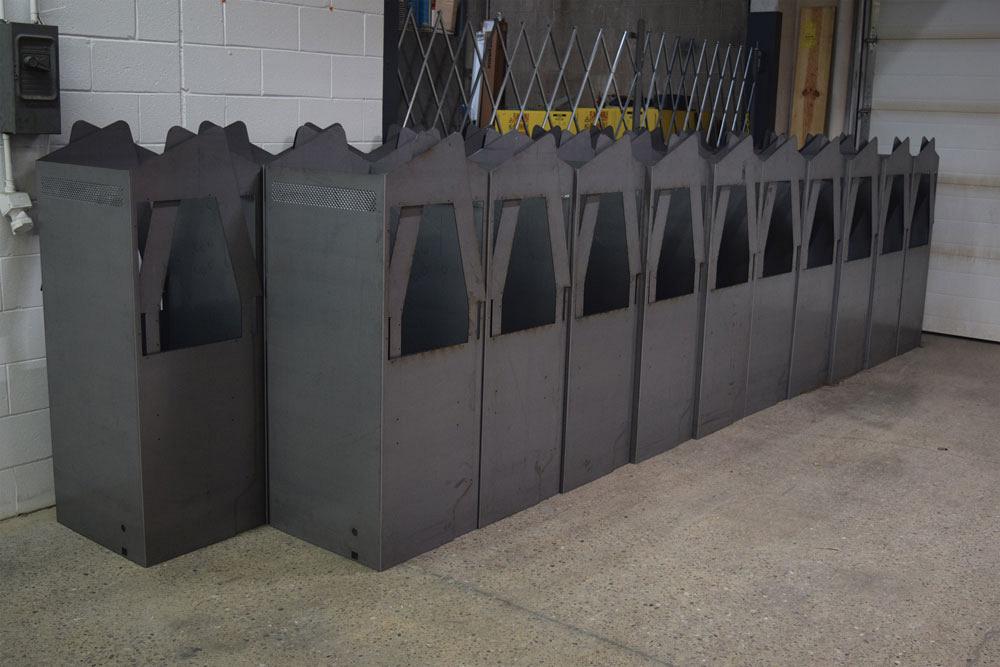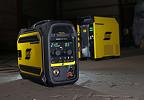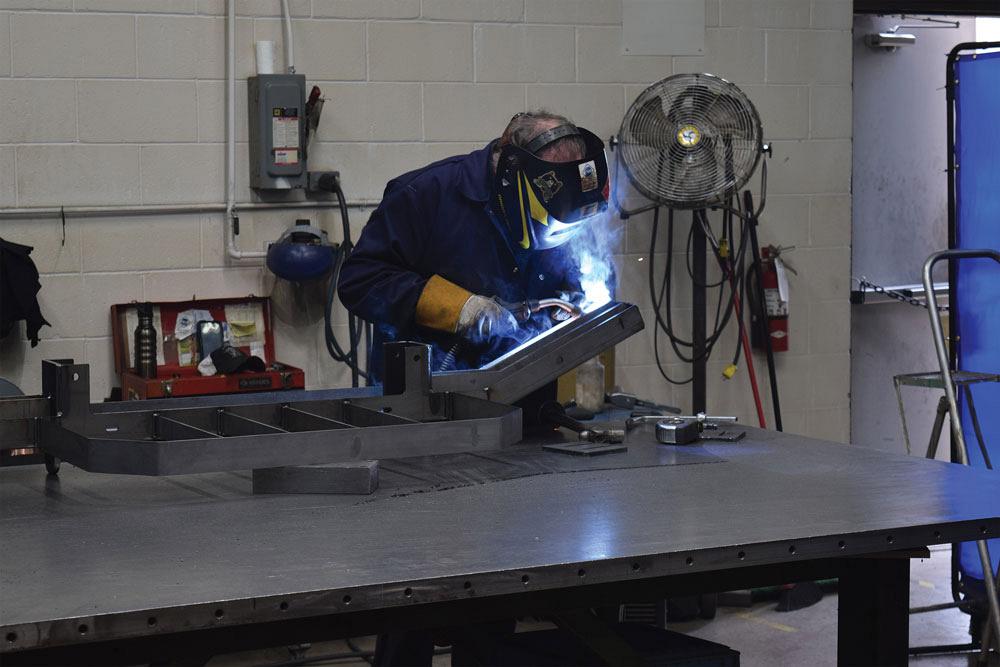Editor
- FMA
- The Fabricator
- FABTECH
- Canadian Metalworking
JVC Precision gears up for ERP implementation
Market forces demand reorganization for growth at Orillia, Ont.-based shop
- By Rob Colman
- May 17, 2017
- Article
- Fabricating

JVC Precision co-owner Michael van Campen (l) with Kenkyo Consulting's Bryan Edwards with a kiosk assembly JVC fabricates, assembles, and ships for its customer.
Orillia, Ont.-based JVC Precision first opened its doors 10 years ago. It is a family-run business that has maintained itself through laser cutting, forming, and some assembly work. The business steadily grew such that, two years ago, JVC bought the building it operated in and took over the whole property. However, to encourage further growth, co-owner Michael van Campen knew that he needed to streamline operations and introduce an ERP system to help manage the shop. That desire has led to a redesign of the JVC facility, the introduction of new processes, and a realignment of the JVC team.
Transition Mission
Michael van Campen has been considering how he wants to see JVC Precision grow for some time now. He started the business with his father John in 2007. John continues to be a valuable part of JVC Precision for matters relating to production, though not to the day-to-day operations of the business.
This hasn’t been an easy transition. Considering the success that they have had, John was hesitant to invest time and money in new processes, consultants, software, and large-scale organizational and facility changes. He also saw a company that was successful, so why mess with what has worked for nine years?
Michael, as someone in his early 40s, sees things differently, and also sees more clearly where they have struggled in the past couple of years.
“There is nothing wrong with a mom-and-pop shop, but I have greater aspirations for the business,” he explained. “We started as a shop that cut and bent parts for people, but margins on doing simple jobs like that aren’t going to keep us in business. We need to offer our customers more, and the way we previously operated made it difficult to do that.”
Michael previously brought in a salesperson to drive new business, but at some point they weren’t capable of managing the volume of orders they were getting efficiently, effectively, and profitably.
The big question was, how was JVC going to rejig the business for growth? What did that future business look like?
To help him work through his growth plans and ERP implementation, JVC brought Kenkyo Consulting onboard. Kenkyo is a small consulting business owned and operated by Bryan Edwards, a former business information subject matter expert and a services sales executive for several global software and consulting firms, including FICO, SPSS, IBM, and SAP. He launched Kenkyo to help local small and medium-sized businesses improve their operations through the use of modern technology and industry best practices. He and van Campen have known each other for eight years and talked about doing some work together earlier. When Edwards launched his business, JVC became his first customer. In the past year he’s been kept busy.
“The big thing for me is I didn’t want to work with a consultant who was another fabrication guy,” said van Campen. “I wanted someone who would view the business in a different way, someone with a fresh set of ideas.”

JVC Precision has grown rapidly over the past year to be able to effectively fabricate and assemble products for clients in a carefully controlled environment.
One of the first things Edwards did was sit down with each person on the team to get a sense of what they did and the role they played in keeping the doors open.
“My approach is, let’s call to light the problems, and if the problems point to a certain process, machine, or person each time, then we need to address that,” Edwards said. “It’s not so much about laying blame, or picking on individuals, it’s about getting to the root cause of the problem and coming up with solutions. Having a third party makes it easier to ask and address the difficult questions.”
Van Campen certainly appreciated having an outside view of the situation. When you are running a business with about 25 employees, it is hard to keep a professional distance sometimes. “Personnel changes are hard to make, but Kenkyo was able to help me see clearly problems we were having, and it made having those discussions with people easier.”
A Focused Business Model
Initially one of the big concerns was that several team members were wearing too many hats. The chief designer, for instance, was doing purchasing as well as serving in other managerial roles. In fact, three different individuals were making purchasing decisions on-the-fly, and there was no accountability. This is just one example of how roles were inefficiently blended, leading to poor purchasing decisions and work flow issues on the shop floor.
“When we started to reorganize, some of those people no longer fit,” said van Campen. “We are trying to build a positive work environment for all, and when you have those people on your team who don’t share the vision or repeatedly push back on proposed changes, you just need to let them go. When you have to let a few go, you think it’s going to be disruptive, but surprisingly enough, it isn’t. Only a few days later [the shop is] back to normal.”
As they reorganized responsibilities, they also redefined the company’s mission statement. JVC has always had a mission statement, but it wasn’t driven by it, per se.
“I reviewed all of JVC’s accounts and found that less than 20 per cent of its clients accounted for more than 80 per cent of its business,” said Edwards. “So we had hundreds of jobs that cost us so much in administration and logistics that there was barely any profit in doing them. Our goal became to see how much value we could add for that small group of customers that were keeping JVC profitable, while better managing the requests of smaller clients. JVC became more cost-conscious about their operations.”
Meanwhile, to ensure a better overall customer experience, several people were either realigned or added to the team to fill strategic roles. For example, Brett Fulford, long-time employee and co-owner who previously managed a number of tasks including design and purchasing, is now going to focus on managing JVC client programs and projects, while a new manager is brought onboard to focus solely on finding new ways to design and deliver client information in a way that empowers them to do more with their end customers.
To help meet growing client demand and process orders more quickly on the shop floor, van Campen purchased an Amada HG 1303 press brake to work alongside the shop’s Amada HDS 8-axis, 130-ton press brake.

A critical bottleneck for JVC at one point was its bending capacity. To help meet growing client demand and process orders more quickly on the shop floor, the shop purchased an Amada HG 1303 press brake to work alongside its Amada HDS 8-axis, 130-ton press brake. The new brake can handle a full range of material thicknesses in bend lengths from 55 to 169.3 in. It is equipped with a newly developed AMNC 3i (intelligent, interactive, integrated) control with a 19-in. LCD touchscreen.
“These two machines are the funnel into our weld assembly side of the business,” said van Campen. “The new brake is a little faster, with a bigger screen on its control. Our laser cuts really fast, so to try to speed things up we brought this machine in. We like that we can use our existing Wila tooling on both machines as well.”
The brake is equipped with a newly developed AMNC 3i (intelligent, interactive, integrated) control and a 19-in. multi-touch LCD panel. The screen is designed for intuitive operation (similar to a smartphone), allowing for fast and efficient entry even if an operator lacks experience. In fact, a new young operator has been brought onto the team to manage this more advanced brake.
One of the biggest problems for the shop floor was the paper trail starting in the front office. Now there is one purchaser and one person who manages inventory and shipping/receiving. As these roles have been sorted, the work flow to the shop has been better structured.
“The guys on the shop floor are quite capable of building quality parts on time if they are given all the relevant facts,” said Edwards. “Because we were disorganized in the front office, that wasn’t happening. With roles more clearly defined in the front office, that is no longer a problem.”
Inventory Management
Inventory management was JVC’s single biggest challenge on its journey to introducing an ERP system. For all intents and purposes, it didn’t previously exist.
“When we first went for ERP training, we realized we weren’t ready to implement it because we had to assign a product number for everything in the shop and we weren’t organized enough,” said Edwards.
“Our ERP implementation plan really forced us into creating an organized tool crib, and introducing better sheet and tube management,” said van Campen. “The tool crib organization was a valuable one for us. Initially we just created a space for it and informed everyone that all tools, fasteners, and fittings had to be stored there. Once everyone was used to going to that space for their needs, we assigned people to manage that inventory. It’s a work in progress but it has proven valuable to have the team directly involved in simplifying the management process.”
With both tools and materials now efficiently organized, the shop has a clean flow to it, and space has been newly dedicated to assembly work.
“Now that we have started to advertise JVC’s assembly capabilities, we have a client who has asked us to take on assembly work they formerly performed in their facility,” said Edwards. “We are now handling all of their design, fabrication, powder coating, and assembly work, and are shipping the finished product overseas directly from our facility after going through stringent quality control checks.”
ERP Choices
Choosing the right ERP system was yet another challenge. A lot of the systems JVC looked at were modular; you had to pick and choose from many different options, so it was hard to determine what the cost was going to be. Van Campen wanted something all-encompassing.
At the same time, many systems appeared geared to long-run production facilities, rather than the low-volume, high-mix environment typical of smaller fab shops.
Perhaps the biggest challenge, of course, was comfort with the supplier; van Campen kept asking himself, Is this a company we want to go forward with? Do they understand the industry? A big part of van Campen’s due diligence was talking to other companies that worked with the system they were considering.
JVC ended up going with Global Shop Solutions’ ERP system. The system is hosted in the cloud so that the shop can focus strictly on being a fab shop and not worry about IT concerns. The system includes advanced planning, scheduling, financial management, inventory management, and document control.
“Global Shop Solutions’ ERP helps us with communications on both the customer and the supplier side,” said Edwards. “The messaging system can give our customers updates about production as we get to certain places in our production process. The ERP system lets them know when they can expect delivery and tells them in real time when something is behind schedule.
“The ERP system also keeps track of what is in our inventory, and we can set limits for what is supposed to be on the shelf,” he continued. “When it hits a certain threshold, it can automatically inform our vendors that we require more. This really gives us a chance to develop our relationship with our vendors and makes it possible to better manage costs. We trust our ERP supplier, and they help us simplify our manufacturing.”
Communicate, Communicate
JVC Precision is a completely different environment compared to what it was just a few years ago. Along with all of the management changes, van Campen had a suite of offices and a boardroom built to create a welcoming environment to both front-office staff and customers. The former shared office space is now an employee lunchroom. He’s also added security controls to all entrances. With the effective completion of the ERP rollout (which is still in-process), he wants to be ready for the next step, which may involve becoming ISO compliant.
As with any implementation, communication is always a big hurdle, and van Campen and Edwards are constantly working at that. Determining what is too much and what is not enough is very difficult, and they don’t pretend to have all the answers.

The key to starting out on the company's ERP implementation journey was getting better control of the shop's inventory.
If anything, having his father John to explain his plans to has been a surprisingly helpful challenge.
“While my father and I haven’t always shared the same business vision, he has been a driving force behind our success to date, and I’m fortunate to have him close by to slow me down at times and make me think through our next move,” van Campen explained.
Editor Robert Colman can be reached at rcolman@canadianfabweld.com.
JVC Precision, 705-327-6566, www.jvcprecision.com
Kenkyo Consulting Inc., 416-567-0706, www.kenkyo.ca
Global Shop Solutions, 800-364-5958, www.globalshopsolutions.com
Amada Canada Ltd., 905-676-9610, www.amada.ca
Wila USA, 443-459-5496, www.wilausa.comAbout the Author

Rob Colman
1154 Warden Avenue
Toronto, M1R 0A1 Canada
905-235-0471
Robert Colman has worked as a writer and editor for more than 25 years, covering the needs of a variety of trades. He has been dedicated to the metalworking industry for the past 13 years, serving as editor for Metalworking Production & Purchasing (MP&P) and, since January 2016, the editor of Canadian Fabricating & Welding. He graduated with a B.A. degree from McGill University and a Master’s degree from UBC.
subscribe now


Keep up to date with the latest news, events, and technology for all things metal from our pair of monthly magazines written specifically for Canadian manufacturers!
Start Your Free Subscription- Trending Articles
CWB Group launches full-cycle assessment and training program

Achieving success with mechanized plasma cutting

3D laser tube cutting system available in 3, 4, or 5 kW

Brushless copper tubing cutter adjusts to ODs up to 2-1/8 in.

Welding system features four advanced MIG/MAG WeldModes

- Industry Events
MME Winnipeg
- April 30, 2024
- Winnipeg, ON Canada
CTMA Economic Uncertainty: Helping You Navigate Windsor Seminar
- April 30, 2024
- Windsor, ON Canada
CTMA Economic Uncertainty: Helping You Navigate Kitchener Seminar
- May 2, 2024
- Kitchener, ON Canada
Automate 2024
- May 6 - 9, 2024
- Chicago, IL
ANCA Open House
- May 7 - 8, 2024
- Wixom, MI

















